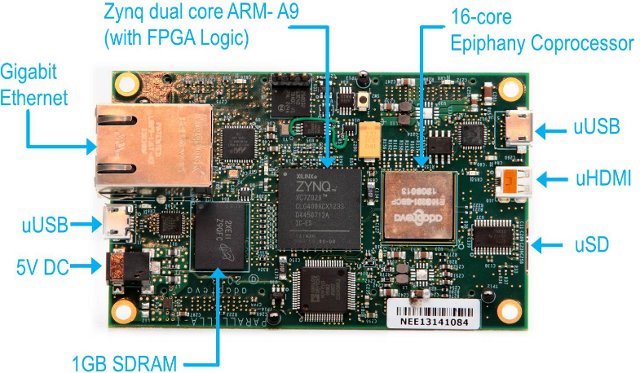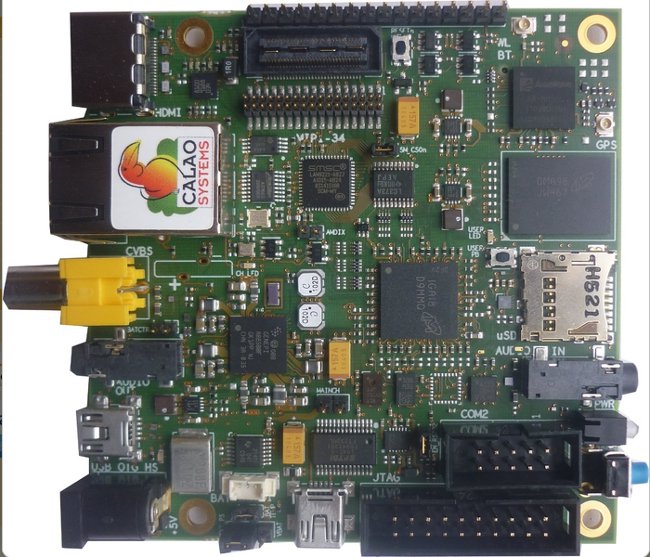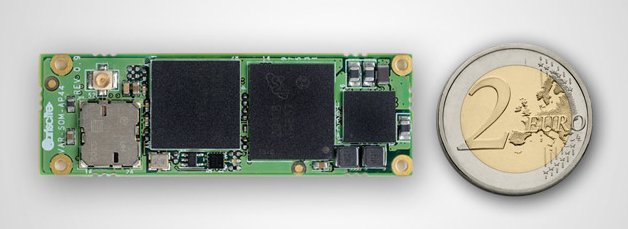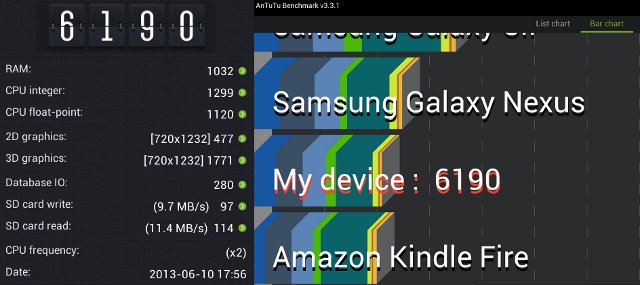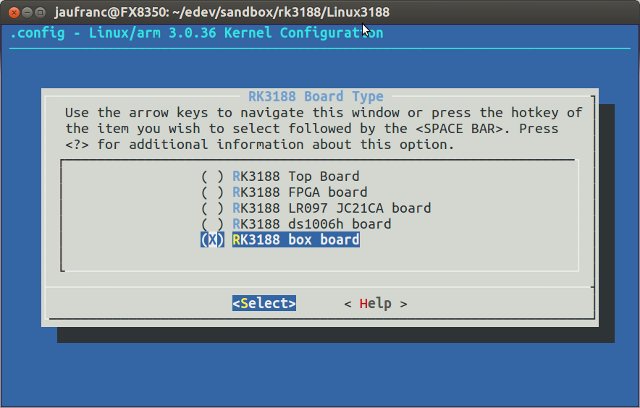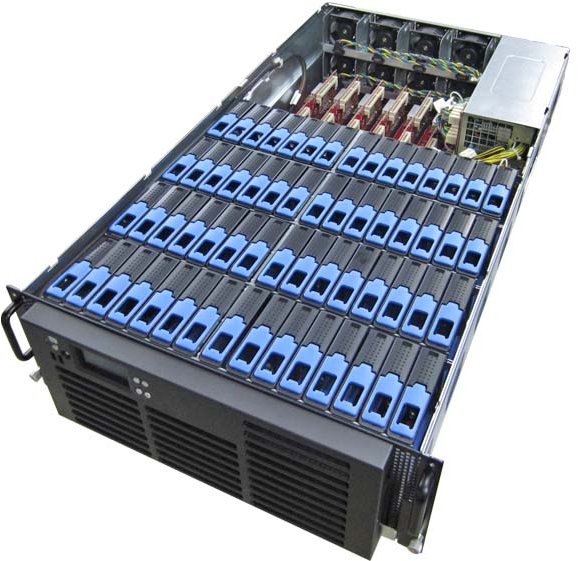Parallella is a low cost supercomputer designed by Adapteva using Xilinx Zynq-7010/7020 FPGA+2x Cortex A9 SoC combined with Adapteva Ephipany 16 or 64 cores epiphany coprocessor. The project had a successful kickstarter campaign which allowed then to provide the 16-core version for $99, and the 64-core version for $750. The board will soon be shipped to people who pledged on kickstarter, and one of the promise of the campaign was to fully open source the platform, and today, they just fulfilled that. Before going into the details of the open source release, let’s have a look at the specs: SoC – Xilinx Zynq7000 Series (Z-7010 or Z-7020) Dual-Core ARM Cortex A9 with 512KB L2 Shared Cache Coprocessor – Epiphany Multicore Coprocessor. The Parallella-16 board includes the 16-core Epiphany-III processor The Parallella-64 board includes the 64-core Epiphany-IV processor System Memory – 1024MB DDR3L Boot Flash – 128 Mb QSPI Flash Indicators […]
Snowball Board Phased Out, and Offered at a Discount
Snowball is a mobile development board based on ST Ericsson Nova A9500 dual core ARM Cortex A9 SoC , which was officially supported by Linaro (they still released Android and Ubuntu images), and designed by Calao Systems, but since ST-Ericsson venture fell apart, support for the board has been discontinued, and the developer’s community (igloocommunity) has recently been closed down. The last message of the mailing list (now not accessible) reads as follows: A small team of passionate ST-Ericsson people have dreamed about Snowball and they makes it possible. Since December 2011 after a management change, it has been difficult to maintain the program, but with your support, we succeed until this time. Nevertheless, you have been able to demonstrate the pertinence of this program, and its great potential with impressive realizations. In December 2012, STMicroelectronics announced a new strategic plan, where STM takes the decision to exit ST-Ericsson. Then […]
Linaro 13.06 Release With Linux Kernel 3.10 and Android 4.2.2
Linaro 13.06 has been released with Linux Kernel 3.10-rc6 and Android 4.2.2. Linux Linaro Stable (LSK) preview is based on kernel 3.9.6. There seems to have been a lot of activity for the LAVA and Builds and Integration teams, with LAVA support for new SoC such as Huawei K3V2 and Broadcom Capri from 2 companies which have recently joined Linaro as members, and well as continuous build for Linaro Stable Kernel. On the kernel side, more work has been done for multi-platform support (unified kernel), uprobes, eMMC power mamangement, and more. Here are the highlights of this release: LAVA LAVA Core As part of the effort to improve the developer experience with LAVA, the different client tools were consolidated into a single package, which simplifies the process of updating the tools and makes it easier for the team to provide new features for LAVA users. LAVA now supports KVM devices, […]
Ubuntu 12.04 Now Boots on Rockchip RK3188 mini PCs (T428, MK908, Rikomagic MK802 IV…)
After the release of the RK3188 Linux kernel source code last week, Ian Morrison (Linuxium) has managed to boot Ubuntu 12.04 with XFCE desktop on Tronsmart T428. However, as Tronsmart refused to release their source code, further Linux development is likely to happen on Rikomagic MK802 IV, because Rikomagic released the code for their device, so development work will be easier. AFAIK, this is the first time Linux boots natively on RK3188 devices, so it’s still early stage (no Wi-Fi, Bt or graphics acceleration), but if you still want to give it a try here are the instructions (for T428):] Create a SDCARD with an Ubuntu 12.04 root file system on it and ensure it is labeled as “linuxroot” (Visit Slatedroid for details) Flash your RK3188 minipc with rooted stock 4.1.1 ROM. (May not be needed if you ROM is already rooted) Boot Android, and install Android Terminal Flash t428-3.0.36-linuxium-test+-kernel.img […]
Variscite DART-4460 SoM is Small, Very Small, and Powered by TI OMAP4460
Variscite announced DART-4460, a new system-on-module based on Texas Instruments OMAP4460, with up to 1GB LPDDR2 RAM and 8GB eMMC flash. The key differentiating point of this module is its size (17 mm x 52 mm), which could make it the world smallest dual core module, although Logic PD’s DM3730 / AM3730 Torpedo SOM might be the smallest of all in single core configuration. DART-4460 system-on-module specifications: SoC – Texas Instruments OMAP4460 dual core cortex A9 @ 1.5 GHz max + PowerVR SGX540 GPU System Memory – 512 to 1024 MB LP-DDR2 Storage – Up to 8 GB eMMC + 2x SD / MMC Video – 1080p30 H.264 Encode / Decode Camera Interfaces – 2x CSI, 1x CPI Display HDMI 1.3a 1920 x 1080 24-bit RGB 1400 x 1050 24-bit DSI 1400 x 1050 4-wire resistive touch Connectivity Wi-Fi 802.11 b/g/n Bluetooth 4.0 Audio – Headphone, digital microphone, S/PDIF, Line […]
Wandboard Dual Benchmarks, Serial Console Fun, and Distributions List
Since last time I tried Android and Ubuntu on the Wandboard, a few things happened. I’m not talking about Wandboard Quad announcement, but instead I received a Class 10 SD card, which makes the system so much responsive, and a RS232 to USB adapter so that I can access the serial console. So today, I’ll publish some benchmark results on Wandboard Dual since none appear to be available, and play a little with the serial console. A few things also happened on the operating systems side with more distributions now available for the board. Prerequisites I ran benchmark in Android, so I installed the latest Android 4.1.2 image (11th of April 2012) to my new SD card (ADATA 16 GB Class 10), and contrary to my poor experience on a 4GB Class 4 micro SD, everything was very fluid. I’ve also installed Google Play in order to install the applications. […]
Rockchip RK3188 Linux Source Code is Now Available
Good news! I’ve just read Rockchip RK3188 Linux source code has just been released via Rikomagic, and Alok Sinha, the main maintainer of RK3066 source code, has already imported into github, and we should soon see a PicUntu image for RK3188 mini PCs. Let’s have a look:
[Update: you may have to run “sudo apt-get install libc6-i386” before running make_kernel_ruikemei.sh below, as mkkrnlimg is a 32-bit binary] Usually, I immediately look into arch/arm/configs, but this time, there’s a “funny” script called make_kernel_ruikemei.sh, and .config already have some CONFIG_RK3188, so let’s run it:
After just over a minute, success!:
This kernel image is for Android only, and there’s a little work to modify it as a “pure” Linux kernel, so that it can be used to boot PicUnutu for RK3188. Let’s go back to arch/arm/configs, and we’ll find several RK3188 configs: rk3168_86v_defconfig rk3188_dongle_defconfig rk3188_ds1006h_defconfig rk3188_ds1006h_v1_0_defconfig rk3188_hotdog_defconfig rk3188_LR097_defconfig rk3188_magicwand_defconfig […]
Calxeda Showcases Aaeon and Foxconn ARM Servers at Computex 2013
ARM started to get involved in servers in 2011 with the announcements of Calxeda Energy Core, Marvell, and Applied Micro X-Gene Servers-on-a-Chip, and in 2012, products made by companies such as HP and Mitac started to appears. We’ve got to see some more ARM based servers this year thanks to Charbax, who filmed some Aaeon and Foxconn servers powered by Calxeda EnergyCore quad core ARM Cortex A9 SoC at Computex 2013. The first server is Aaeon Indus 1U cloud storage appliance: 1U Chassis 2x Calxeda Energycore nodes 10x 3.5″ HDD 2x 10 GbE uplinks and 4x 10GbE chassis-to-chassis interconnects Foxconn server shown at Computex has slightly higher specs: 4U chassis 12 Calxeda Energycore nodes 60x 3.5″ HDD for up to 240TB storage 4x 10 GbE uplinks and 6x 10 GbE chassis-to-chassis interconnects for 100 GbE total bandwidth There’s also a Gigabyte server, but I could get details. Server based on […]


